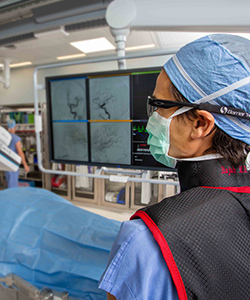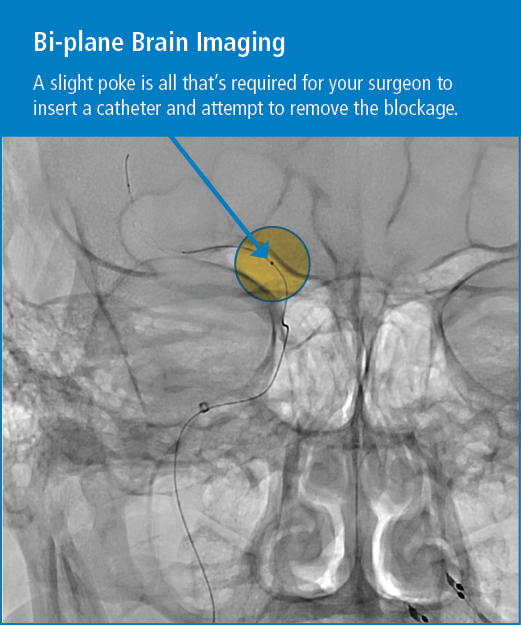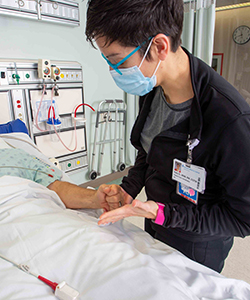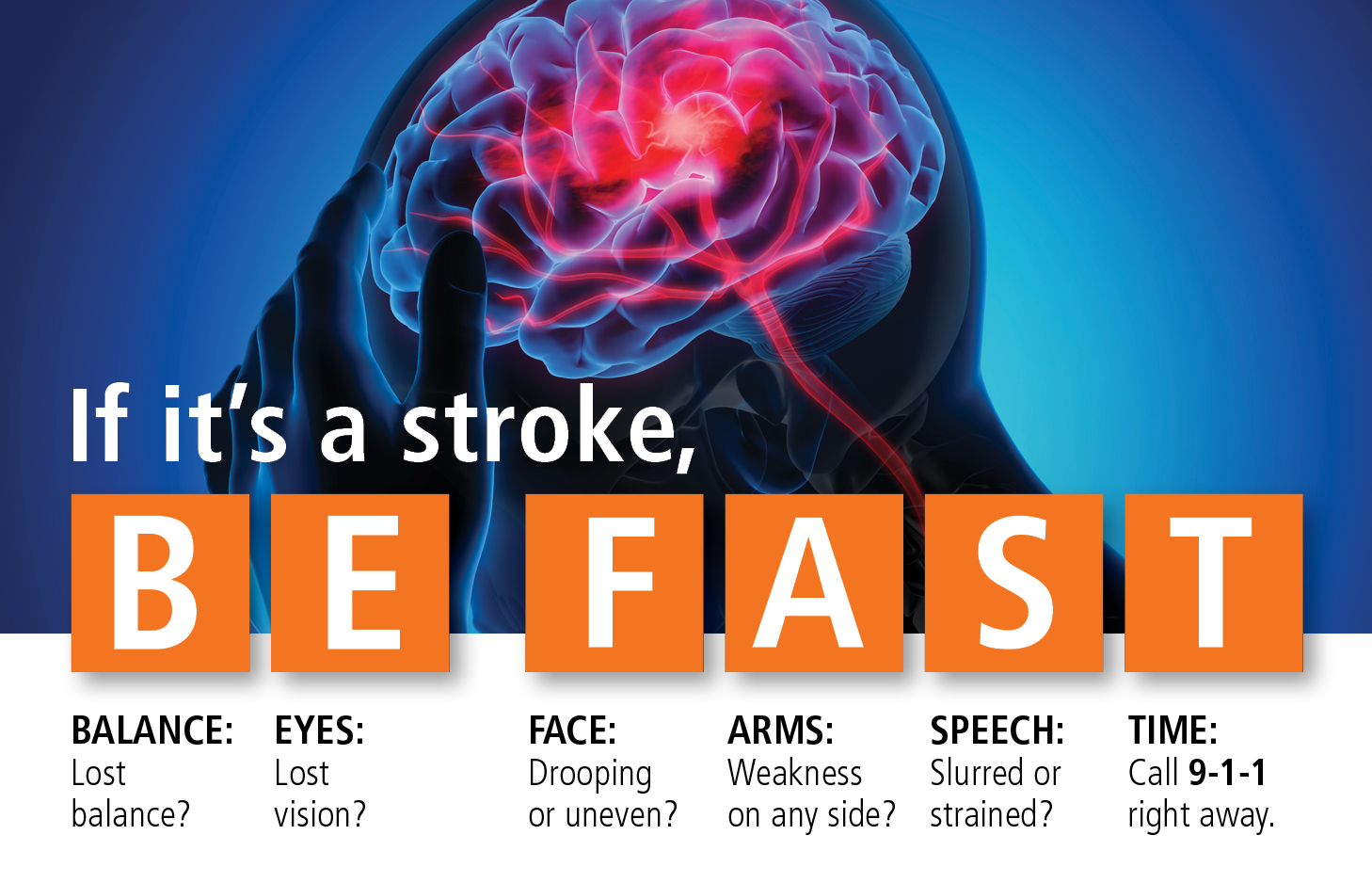Minimally-Invasive Stroke Care Saves Lives

During a stroke, minutes matter. And Ann McCain might understand this better than anyone.
It was a typical September morning in Suttons Bay for the 57-year-old. Ann woke up with a terrible charley horse cramp in her left leg. Not out of the ordinary, she walked across her home’s main floor and into the kitchen for breakfast. When she asked her Alexa device to turn the lights on, her husband Bill immediately knew something was wrong.
“Ann came into the kitchen and yelled for Alexa to turn on the lights,” Bill said. “I was just a minute behind her. Right then I noticed her slurring her words. Then I noticed her walking was strange. When I saw her eyes, I knew we were halfway there. At least three out of five signs I remembered.”
The signs Bill mentions are part of BE FAST, a helpful acronym to remember the symptoms of a stroke. Thankfully, Bill had been staring at a BE FAST reminder flyer for years in his breakroom at work.
Bill recognized Ann’s speech was slurred, but that wasn’t all. Ann was off balance. And her face was drooping.
Recognizing the signs of stroke, he also knew that time was of the essence. Bill called 9-1-1 and the race against time began.
Interventional Stroke Care in Northern Michigan
An ambulance rushed to Ann’s home. And within minutes she was transported to Munson Medical Center in Traverse City, the hub of Munson Healthcare’s Regional Stroke Network. Under this new model of care, suspected stroke patients across northern Michigan will be evaluated at the nearest emergency department and quickly moved to the Medical Center if surgical intervention is necessary.
At Munson Medical Center, a team of multidisciplinary stroke experts performed an immediate clinical evaluation using advanced non-invasive imaging. Results confirmed a suspected ischemic stroke with a large blockage behind Ann’s eye in the main artery to the right side of her brain.
An ischemic stroke occurs when an artery (or blood vessel) is blocked by a clot and cuts off blood flow to part of the brain. Symptoms may include numbness or weakness on one side of the body and problems with balance, speech, and swallowing. Almost exactly the symptoms Ann was experiencing.

Without a blood supply, brain cells can be damaged or destroyed because they may not receive enough oxygen. Two million neurons (brain cells) die per minute during a stroke, affecting the patient’s ability to perform everyday tasks like speaking, swallowing, and controlling bodily functions.
Every minute left Ann more at risk of permanently losing her speech and functional movement of her left arm and leg. And worse, if the right side of her brain died irreversibly, the resulting brain swelling could be fatal.
Thrombolysis, or TPA medication, is a clot-busting drug treatment normally given within four hours of an ischemic stroke to dissolve a blockage. But TPA is time-limited and infrequently works on large blockages. Since Ann and Bill weren’t sure when her symptoms actually began, TPA was not a recommended treatment.
With the clock ticking and TPA not an option, Ann and Bill consented to a mechanical thrombectomy – a minimally-invasive interventional procedure now performed at Munson Medical Center as part of Munson Healthcare’s premier stroke network. Munson Medical Center is the only interventional stroke center of its kind in northern Michigan to offer the latest in neurovascular techniques and technology.
Thrombectomy Procedure Removes Blockage
Mechanical thrombectomy is the gold standard of care for sudden ischemic strokes in the brain’s large blood vessels. This procedure aims to remove the obstructing blood clot, restore blood flow, and minimize brain tissue damage.
Munson Medical Center began performing thrombectomy procedures in mid-August after Vascular Neurosurgeon Gary Rajah, MD, Director of Munson Healthcare’s Endovascular/Interventional Stroke Program, brought the team and equipment into place. Preparation began in June.
“Previously, neurovascular cases such as strokes, aneurysms, and brain hemorrhage due to a vascular lesion were sent downstate, with the nearest center being over 140 miles away,” Dr. Rajah said. “I am honored to be a part of Munson Healthcare and I took this role in spearheading the neurovascular program because I wanted to bring these services to an area with a clear need. The Munson Healthcare Stroke Network will cover northern Michigan and make sure all residents now have timely access to neurovascular care.”

During the surgery, Dr. Rajah threaded a catheter through Ann’s wrist artery under an x-ray to locate the blockage in her head. He then inserted a small stent/snare retriever on a long wire to capture and remove the clot. This is known as an endovascular procedure because surgeries follow the vascular system (blood vessels and arteries) to find the blockage. Mild sedation and a small poke on the wrist artery are all that is required for this minimally-invasive procedure.
“We were able to open a potentially very deadly, functionally devastating large vessel occlusion in under 30 minutes, with Ann awake,” Dr. Rajah added. “This is a feat which would have required a very lengthy helicopter transfer previously, putting Ann at risk of never returning to her baseline independent self, or worse.
“Seeing patients like Ann return to their families and normal lives after a stroke diagnosis is the best part of my job, and our team at Munson Healthcare feels the same way.”
Mechanical thrombectomy procedures have been shown to significantly improve disability-free survival and quality of life for patients like Ann when performed within 24 hours of a stroke.
-
Patients are 10 to 40 percent more likely to have an excellent or good recovery (still able to care for themselves) at 90 days.
-
Up to 40 percent of patients also have less disability overall as compared with those who received other stroke treatments.
Interventional Care Leads to Positive Outcome
After a successful surgery and weeklong inpatient stay, Ann left Munson Medical Center to complete her rehab and recovery.

“I have trouble with things like seatbelts and zippers, but overall I'm doing a whole lot better,” Ann said. “Considering some people completely lose their vision after a stroke, I know I’m doing much better than most. After all, I’m still alive!”
Alive, and back to playing Frisbee outside with her two dogs, a border collie named Iggy Pup, and a corgi, Ellie. But playtime now is from a seated position and for shorter periods until her body is ready. Ann’s rehab team continues to focus on helping overcome minor left-side differences and mild speech issues.
Over time, Ann’s physical therapists are encouraged that she could get back to 100%.
Ann credits every member of the healthcare team who contributed to her stroke intervention. “I don’t remember a lot about the procedure, but I remember Dr. Rajah’s face. He’s very kind and super sweet,” she said. “I still want to bring in cookies to thank everyone. I make snickerdoodles like you wouldn’t believe.”
Recovery from stroke depends on many factors, such as where in the brain the stroke occurred, its severity, the age of the patient, and his or her medical history. No two people are affected in the same way.
When Minutes Matter, Make it Munson

A stroke can happen to anyone at any time.
Munson Healthcare Stroke Center physicians are the only team performing advanced interventional stroke procedures in northern Michigan. The team is specially-trained in minimally-invasive techniques and world-class brain imaging technology.
Munson Healthcare hospitals in Cadillac, Charlevoix, Gaylord, Grayling, Frankfort, Kalkaska, Manistee, and Traverse City can quickly diagnose and evaluate a stroke For acute stroke patients, that means life-changing interventional care, provided faster and safer than ever.
If you or someone you love shows symptoms of a stroke, BE FAST. Call 9-1-1 immediately:
B - Balance problem
E - Eyes/vision problem
F - Face drooping
A - Arm weakness
S - Speech difficulty
T - Time to call 911
“Don’t wait for symptoms to resolve,” Dr. Rajah added. "Call 9-1-1 and tell them you think someone is having a stroke. Getting to the nearest emergency room as fast as possible is very important. If any intervention or open surgical procedures are necessary, we will be able to take care of those at Munson Medical Center as timely and efficiently as possible."
If you or someone you love shows symptoms of stroke, BE FAST and call 9-1-1 immediately.
When minutes matter, make it Munson: Northern Michigan’s premier stroke network. To learn more, visit munsonhealthcare.org/stroke.